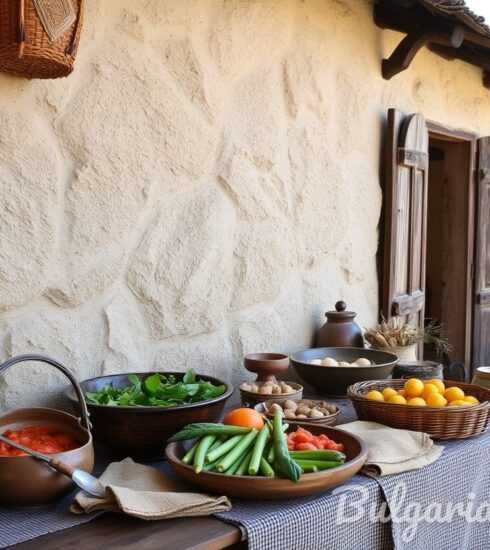Discover Bulgarias Culinary Heritage: Timeless Recipes and Family Traditions
Flavors of the Past: A Culinary Journey Through Bulgaria’s Timeless Recipes and Family Traditions
Bulgaria has long been a crossroads of cultures and cuisines, where the flavors of the past intertwine with modern culinary practices. This rich tapestry of historical influences includes Thracian, Slavic, and Byzantine elements, resulting in a distinct culinary heritage that resonates throughout its regions. In
The Historical Context of Bulgarian Cuisine
The roots of Bulgarian culinary traditions can be traced back to ancient civilizations. The Thracians, who inhabited the area from prehistoric times, cultivated grains, fruits, and vegetables. They are known, for instance, for their wine-making skills, which have evolved but still play an essential role in Bulgarian culture today.
During the Byzantine Empire, the exchange of culinary techniques and ingredients further enriched Bulgaria’s food landscape. The Ottomans introduced a variety of spices and cooking methods that are still evident in many traditional dishes. Additionally, the introduction of new products such as potatoes, tomatoes, and peppers during the Colombian Exchange led to the adaptation of classic recipes, showcasing a dynamic culinary evolution.
Mains and Meze: The Heart of Bulgarian Meals
At the core of Bulgarian meals lie the concepts of ‘mains’ and ‘meze’ (appetizers). Traditionally, meals are communal affairs. They often start with a selection of meze that encourages sharing and conversation. The following are some popular meze that highlight the bulgaria culinary heritage:
- Sirene: This is a brined cheese made from sheep’s milk, often accompanied by fresh tomatoes and cucumbers.
- Shopska Salata: A refreshing salad made with diced tomatoes, cucumbers, onions, peppers, and topped with grated sirene cheese.
- Lyutenitsa: A spicy spread made from roasted peppers and tomatoes, typically served with bread.
- Tarator: A cold soup made from yogurt, cucumber, garlic, and walnuts, perfect for hot summer days.
Hearty Main Dishes

The main courses are where heartiness meets flavor, often showcasing meat, grains, and vegetables in various forms. Some classic Bulgarian dishes include:
- Banitsa: A flaky pastry filled with a mix of eggs, cheese, and yogurt, often enjoyed for breakfast or as a snack.
- Kavarma: A slow-cooked dish featuring pork or chicken, onions, and spices, served in traditional clay pots.
- Sarmi: Grape leaves stuffed with rice, minced meat, and spices, simmered in a tomato sauce.
- Katmis: A dish made with chicken or pork cooked with egg and yogurt sauce, offering a velvety finish.
Preservation of Culinary Traditions
As society evolves, many Bulgarian families continue to preserve their culinary traditions. These recipes are often handed down through generations. For many, cooking is seen not just as an act of nourishment but as a way to honor their heritage. According to the UNESCO website, the safeguarding of traditional food practices contributes significantly to cultural identity.
Celebrating Family Gatherings with Food
Bulgarians have a saying, “The best food is when shared with loved ones,” which epitomizes the essence of family gatherings. Major life events such as weddings, birthdays, and holidays often revolve around extensive meals that bring families together.
During Christmas, many households observe a day of fasting (December 24th) followed by a feast that breaks the fast with dishes like:

- Stuffed Peppers: Peppers filled with rice, spices, and sometimes minced meat.
- Traditional Fish Dishes: Typically carp served with a side of garlic sauce.
- Baklava: A sweet pastry made from layers of filo dough, filled with nuts and honey—an Ottoman legacy.
The Role of Bread in Bulgarian Culture
Bread is emblematic in Bulgarian culture, symbolizing life and community. The most common type is pitka, a round bread served on special occasions. The preparation typically involves family participation:
- The dough is kneaded together, bringing family members closer in the process.
- It’s common to place a coin or a trinket in the bread, with traditions suggesting good luck for the person who finds it during the meal.
According to the Food & Wine magazine, the importance of bread transcends its physical presence, becoming a symbol of sharing and hospitality.
Influence of Regional Diversity
Bulgarian cuisine varies remarkably from region to region, each with its testament to the bulgaria culinary heritage. This diversity highlights the country’s geographical and cultural variations.
Cuisine from the Thracian Valley

The Thracian Valley is known for its wine production and is famous for hearty dishes that utilize locally sourced ingredients. Wine made from local grapes is a staple, often accompanying meals. Dishes from this area are usually rich in meats, particularly lamb and game.
The Black Sea Coast’s Bounty
The Black Sea offers an abundance of seafood, and it plays a crucial role in the cuisine of the coastal towns. Grilled fish and seafood stews highlight the fresh flavors of the sea. Common dishes include:
- Grilled Mackerel: Often served with a drizzle of lemon and olive oil.
- Seafood Risotto: A creamy dish made with local shellfish and herbs, showing Italian influences.
Culinary Events: Festivals That Celebrate Heritage
Throughout the year, Bulgaria hosts numerous culinary festivals that celebrate its food traditions. These festivals often include competitions, tastings, and workshops focused on traditional cooking techniques. Notable among these is the:
- Festival of Bulgarian Cheese: Held in various cities, this event highlights the country’s diverse cheese-making practices.
- Wine and Culinary Festival: Celebrated in regions like Melnik, where attendees can taste local wines paired with traditional dishes.
The Revival of Ancient Grains

With a growing interest in health and nutrition, many Bulgarians are returning to ancient grains like spelt and emmer. These grains provide nutritional benefits and are foundational in restoring traditional recipes, connecting the past with a modern sensibility.
Modern Influences in Bulgarian Cuisine
As globalization continues to influence culinary practices, many innovative Bulgarian chefs are blending traditional recipes with contemporary techniques. The farm-to-table movement has also taken root, emphasizing organic and locally sourced ingredients. These shifts reflect a growing awareness of health and sustainability in food choices.
Chefs are experimenting with new interpretations of classic dishes, such as vegan versions of banitsa or entirely new sauces inspired by the bulgaria culinary heritage.
Practicing Sustainability in Traditional Cooking
Sustainability is becoming an essential conversation in Bulgarian culinary circles. Efforts to promote local farms, preserve biodiversity, and minimize waste are being encouraged. Many chefs and home cooks are embracing the practice of foraging for wild herbs and vegetables, which not only contribute to flavor but help connect people with their natural surroundings.
According to a report by the Food and Agriculture Organization, incorporating sustainable practices into traditional cooking can help protect the environment and preserve the food culture for future generations.
Conclusions on Bulgarian Culinary Heritage
Understanding the bulgaria culinary heritage reveals much about the nation’s identity. The interconnectedness of food, family, and culture reflects the values that have been cherished over the centuries. As Bulgaria continues to evolve, so does its cuisine, merging the flavors of the past with the innovation of the present. Engaging with these culinary traditions not only provides joy and nourishment but also fosters a deeper appreciation of what it means to be part of this vibrant culture.






